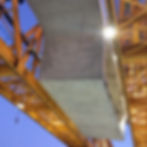
Bayonne Bridge Navigational Clearance Program (Approaches)
Staten Island, New York - Bayonne, New Jersey
Project Description
The Bayonne Bridge opened in 1931 as the world’s longest steel arch span, and it remained so for more than 45 years. Eventually, however, its 151-foot navigational clearance began to hinder the passage of shipping vessels bound for the ports of Newark and Elizabeth.
HDR and WSP formed a joint venture partnership and partnered with the Port Authority of New York and New Jersey to increase clearance to 215 feet to allow passage of modern freighters and help maintain the ports’ economic competitiveness by meeting the deadline for post-Panamax ships coming to market. Raising the roadway 64 feet within the confines of the twin plane arch truss was the most efficient solution. It also allowed traffic to continue using the existing deck during construction.
HDR was responsible for the design of the new deck for the main bridge span; the strengthening of the historic arch for increased loading; and the segmental concrete approach superstructures, while WSP was responsible for the design of the substructure. Racing against the cutoff date for ports to accommodate larger vessels, the design team introduced several innovations to expedite the schedule. Using a creative approach, the new arch superstructure was built above the existing deck to allow for continuous traffic during construction.
For the approach structures, the bold design allowed the new north and southbound piers to be fully independent precast concrete structures. They were steadied by temporary steel pipe struts as opposed to relying on the partial erection of the southbound structure for support. A prefabricated steel truss also replaced the cast-in-place concrete strut at the mid-height of the tall piers. By utilizing pre-fabricated design elements and eliminating the need to build a portion of the southbound structure, the construction sequence was streamlined, condensing the overall construction schedule.
Maintaining the bridge’s original footprint allowed for an accelerated schedule and eliminated right-of-way acquisitions. It also allowed the use of an environmental assessment — instead of the lengthier environmental impact statement — cutting at least three years off the schedule.
The thoughtful design was inextricably linked to construction. Precast segmental concrete construction lowered costs, improved durability and reduced maintenance. Precasting also eliminated the need for concrete trucks to travel through neighborhoods surrounding the bridge as the precast segments were delivered on the previously constructed bridge. Included in the project criteria, the new northbound roadway contains a shared use path and the southbound roadway is designed to accommodate future light-rail transit.
In September 2017, the existing suspended arch roadway was removed and post-Panamax vessels enjoyed unencumbered passage, carrying some 8,000 containers more than previous ships. The holistic approach minimized impacts during construction while accommodating future growth, and extended the life of a landmark bridge by another 100 years. In February 2019, all four lanes were opened to traffic on the new elevated alignment. The new facility was dedicated on June 14, 2019.
Aspire Bridge Magazine Article: Bayonne Bridge - New Bridge Allows Larger Container Ships to Pass
Aspire Bridge Magazine Article: Bayonne Bridge - Design and Construction Features
Location
Spanning the Kill Van Kull between
Staten Island, New York and
Bayonne, New Jersey
Owner
The Port Authority of New York and New Jersey
Contractor
Skanska Koch / Kiewit (Joint Venture)
Designer
WSP (approaches substructure)
HDR (approaches superstructure and main span)
(Joint Venture)
Total Contract Value
$1.68 Billion (Full Project)
$743 Million (Approaches)
Timeline
2013 - 2019
Construction Method
Two precast segmental bridges erected using the balanced cantilever method with overhead gantry and ground-based cranes.
__________________________________________________________________
Our Role
Jason Hatcher worked with construction engineer Finley Engineering Group as a project manager and supervised the development of the construction drawings. Jason performed many tasks on this project, including;
-
Constructability reviews of the approach substructure and superstructure components
-
Coordination with the main contractor and designers to resolve issues of reinforcement and post-tensioning hardware congestion and overall constructability
-
Fully integrated shop drawings for select cast-in-place footings
-
Fully integrated shop drawings for select precast substructure pier column segments
-
Fully integrated shop drawings for select precast superstructure segments
-
Fully integrated 3D models of select precast segments, including;
-
substructure pier column segments
-
substructure pier caps
-
superstructure pier segments
-
superstructure anchor block segments
-
superstructure typical segments
-












